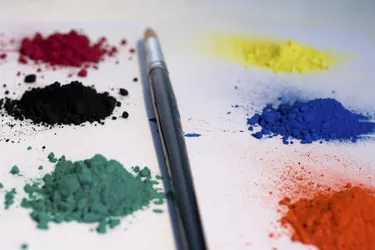
Tempera paint – sometimes known as poster paint – comes in the form of a powdery pigment made from glutinous materials. Today tempera often finds itself used by youngsters in art class, but this powder-based paint has a history dating back to ancient Egypt. Artists can purchase unmixed tempera powder, which requires the addition of water before it can be applied to a canvas, or premixed tempera paints, which come ready to use.
History
Video of the Day
In art history, tempera paint lies between beeswax-based encaustic paints and oil paints. Though artists used tempera powder in ancient Egypt and Greece as well as in the medieval Byzantine Empire, this type of paint came to prominence during the Italian Renaissance. Artists of the Italian Renaissance used tempera on panels and plaster walls to create murals. In the 15th and 16th century, Leonardo Da Vinci and Michelango utilized traditional egg-based tempera powder. The Social Realists of the 19th and 20th centuries – including Paul Cadmus, Isabel Bishop and George Tooker – repopularized the powder-based tempera paint.
Video of the Day
Ingredients
Renaissance artists mixed tempera pigment powder with an egg yolk or whole egg medium to create paint, a tradition that tempera artists of the modern era continue. Some artists add glue, honey or milk to the powder while others use oil as their mixing medium to create a smoother consistency. Traditionally, tempera pigment powder is an organic compound, though some modern tempera powders contain synthetic glutinous ingredients.
Features
Tempera powder is soft to the touch and it retains its soft, smooth qualities when it becomes paint. When mixed with a medium, tempera paint has a thin consistency. As such, it cannot be applied thickly. Tempera dries quickly. Unlike oil paint, its successor, tempera paint does not fade, darken or discolor over time. In fact, tempera paints tend to intensify in color as they dry and age as the water mixed with the powder dries up. Tempera accommodates virtually any artistic style or painting technique.
Process
Artists apply tempera to a smooth prepared surface, commonly wood panels, dry plaster or other smooth surfaces prepped with chalk gesso. At this point in the process, some artists sketch plans for their painting on the surface. They then slowly build thin, transparent layers of tempera. After tempera dries, it is often treated with a varnish – sometimes an egg white-based substance known as glair – to prevent flaking.
Famous Paintings
"Birth of Venus" (c.1485-86) by Sandro Boticelli, which contains the iconic depiction of a nude Venus rising from a seashell, uses tempera paint. Leonardo da Vinci's "Madonna and Child" (c.1490-91) also employs tempera paint. Like many historic tempera paintings, it was painted on a panel and later transferred to canvas. Pablo Picasso's 1919 "Sleeping Peasants" mixes tempera, watercolor and pencils on a paper canvas while Andrew Wyeth's 1949 "Christina's World" uses tempera on a gessoed panel.